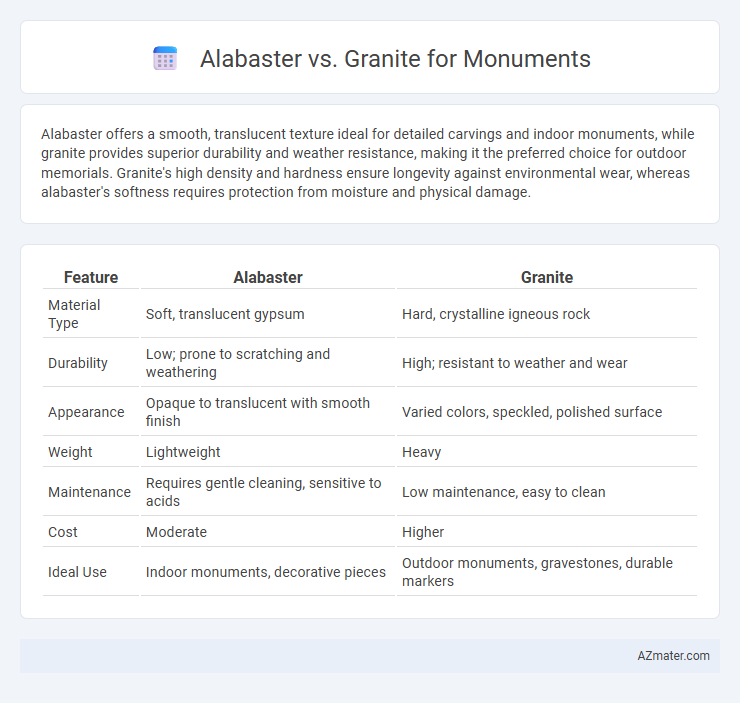Alabaster offers a smooth, translucent texture ideal for detailed carvings and indoor monuments, while granite provides superior durability and weather resistance, making it the preferred choice for outdoor memorials. Granite's high density and hardness ensure longevity against environmental wear, whereas alabaster's softness requires protection from moisture and physical damage.
Table of Comparison
| Feature | Alabaster | Granite |
|---|---|---|
| Material Type | Soft, translucent gypsum | Hard, crystalline igneous rock |
| Durability | Low; prone to scratching and weathering | High; resistant to weather and wear |
| Appearance | Opaque to translucent with smooth finish | Varied colors, speckled, polished surface |
| Weight | Lightweight | Heavy |
| Maintenance | Requires gentle cleaning, sensitive to acids | Low maintenance, easy to clean |
| Cost | Moderate | Higher |
| Ideal Use | Indoor monuments, decorative pieces | Outdoor monuments, gravestones, durable markers |
Overview of Alabaster and Granite
Alabaster, a soft, translucent sedimentary rock primarily composed of gypsum or calcite, is prized for its smooth texture and ease of carving, making it ideal for detailed monument designs. Granite, a hard, durable igneous rock composed mainly of quartz, feldspar, and mica, offers exceptional weather resistance and longevity, suitable for outdoor monuments exposed to harsh elements. The choice between alabaster and granite for monuments depends on desired aesthetics, durability, and environmental exposure.
Geological Formation and Composition
Alabaster, a fine-grained form of gypsum or calcite, forms through the evaporation of mineral-rich waters in sedimentary environments, resulting in a soft, translucent texture ideal for detailed carving. Granite is an intrusive igneous rock composed mainly of quartz, feldspar, and mica, crystallizing slowly beneath the Earth's surface, which gives it a dense, durable, and coarse-grained structure perfect for enduring monuments. The distinct geological origins influence their composition, with alabaster offering softness and translucency, while granite promises strength and weather resistance.
Visual Appearance and Color Variations
Alabaster offers a translucent, smooth surface with soft, creamy hues ranging from white to pale beige, ideal for delicate and ethereal monument designs. Granite displays a rich, speckled texture with extensive color variations including black, gray, pink, and green, providing a robust and classic appearance suited for durable and striking monuments. The choice between alabaster and granite hinges on the desired visual impact--subtle elegance versus bold permanence.
Durability and Weather Resistance
Alabaster is a soft, porous stone that tends to erode and discolor when exposed to outdoor weather conditions, making it less durable for monuments in harsh climates. Granite, known for its hardness and resistance to abrasion, withstands extreme weather and pollution without significant deterioration, ensuring longevity in monuments. Its low porosity and strong mineral composition provide excellent weather resistance, making granite the preferred choice for outdoor memorials.
Workability and Sculpting Ease
Alabaster offers superior workability and sculpting ease compared to granite due to its softer, finer-grained texture, making it ideal for detailed monument carvings. Granite's hardness demands specialized tools and expertise, slowing down the sculpting process and limiting intricate designs. Sculptors often prefer alabaster for its ability to capture delicate details and smooth finishes in monument art.
Cost Comparison and Availability
Alabaster is generally less expensive than granite due to its softer texture and easier carving process, making it a more budget-friendly option for monuments. Granite, known for its durability and wide color range, often comes at a higher cost because of quarrying and finishing expenses. While granite is widely available across global markets with numerous suppliers, alabaster's availability is more limited and region-specific, impacting both price and procurement time.
Maintenance Requirements
Alabaster monuments require more delicate maintenance due to their softness and susceptibility to scratching and chemical damage, necessitating gentle cleaning with mild, non-abrasive agents and avoidance of harsh weather conditions. Granite, known for its hardness and durability, demands less frequent upkeep, typically needing only periodic cleaning with water and mild detergents to retain its appearance and resist staining. Proper sealing of granite further reduces maintenance efforts by protecting against moisture and environmental pollutants.
Symbolic Significance in Monuments
Alabaster symbolizes purity, softness, and spirituality, making it ideal for monuments meant to evoke a sense of peace and reverence. Granite conveys strength, durability, and permanence, representing enduring legacy and resilience in monumental structures. Choosing between alabaster and granite depends on whether the monument's message prioritizes gentle remembrance or lasting power.
Popular Uses in Monument Construction
Alabaster is commonly used for detailed carvings and indoor monuments due to its smooth texture and translucent qualities, offering fine artistic expression in memorials and statuaries. Granite, prized for its durability and weather resistance, is the preferred material for outdoor monuments, headstones, and memorial plaques, ensuring longevity in harsh environmental conditions. Both materials serve distinct purposes in monument construction, with alabaster favored for aesthetic intricacy and granite for structural endurance.
Choosing the Right Stone for Your Monument
When choosing the right stone for your monument, consider alabaster for its smooth texture and ability to capture fine details, making it ideal for intricate sculptures and indoor displays. Granite offers superior durability and resistance to weathering, making it the preferred choice for outdoor monuments exposed to the elements. Evaluate the monument's location, intended longevity, and design complexity to select between alabaster's delicate beauty and granite's enduring strength.

Infographic: Alabaster vs Granite for Monument
 azmater.com
azmater.com